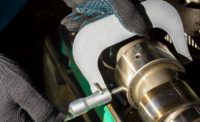
No one likes to hear that their quality system is missing something. More alarming still is hearing that a system is missing a key component that could lead to expensive product sorting or even, forgive me for saying this, a product recall. Collecting accurate data is the first line of defense in quality control and the reality is that many systems are highly lacking in gage control.
There are three major components to gage control systems: measurement system analysis, gage calibration and stability monitoring. Surprisingly, the majority of quality systems do not include all three.
Measurement System Analysis
Measurement system analysis (MSA) should be performed when any new measurement system is being introduced or whenever changes have been made to an existing system. It also is good practice to routinely perform analysis on existing systems.A common misunderstanding is that MSA involves only a gage repeatability and reproducibility study when in fact it includes the entire system. When performing an MSA study, take a close look at the entire measurement process and everything that affects it.
Not everything can be covered, but here are some of the key items to investigate when doing an MSA:
After a thorough MSA is completed for a new measurement system, it can be determined if the system is adequate. If the system meets a company’s needs, they can move ahead with the implementation, which conveniently leads to the next component of the system: gage calibration.
Gage Calibration
When gaging or measurement systems are introduced into production, they should be added to a gage calibration system. Gage calibration ensures that gages are reading accurately and that their readings are traceable to a standard or master source.Gage calibration may be performed in-house or it can be outsourced to a calibration lab. Most companies use a mix of both.
Calibration services can be disruptive and expensive because gages generally are taken off line or even sent to calibration labs, potentially for weeks at a time. Due to the expense, timeframe and large number of gages, companies usually segment calibration into monthly, quarterly or yearly intervals.
Key items for a gage calibration system include:
Feel like a gage control expert? Don’t get too confident yet. Just because the gage has been approved for use and is entered in a calibration program does not mean the system is complete. Many measurement systems also can benefit from stability monitoring.
Stability Monitoring
Stability monitoring is the most often overlooked component of the gage control system. It is used to ensure that gage systems are working properly between calibration cycles.A standard sample or fixture is measured at a set interval with the data plotted on a control chart. The stability check monitors changes in the average over time, but also monitors repeatability and reproducibility of the system.
Why perform stability monitoring if a company is already verifying that the measurement system is acceptable with its MSA study, and they are conducting routine calibrations to make sure that it is measuring on target?
With stability monitoring in place, changes in the system will create events or alarms that allow the measurement system to be calibrated before large volumes of questionable products are created.
For example, let’s say it is discovered that a laser measurement system is giving erroneous readings. This system performs a critical final inspection, and if the feature inspected by the system is not truly within specification, it will cause the product to fail.
There’s an easy answer, right? Just hold the entire production in question and inspect it again. But if it has been weeks since the measurement system has been calibrated, then this task can be quite an undertaking, with numerous repercussions.
Product would be palletized, may have been shipped to warehouses, or worse yet, it may have already been delivered to the customer.
Performing additional inspections is always an unnecessary expense, but when the product has already reached the customer, it results in very expensive recalls and perhaps loss of market share. If only the measurement system had been verified at more frequent intervals.
Stability monitoring is measuring known standard samples at frequent intervals. Multiple readings are taken at each measurement with the average, range and range within plotted on a control chart. The chart will then notify you if repeatability, reproducibility or any abnormal variation occurs in the system.
The frequency of stability monitoring is based on the risk of failure of the system, the production rate and the frequency of process change. Some systems may require a stability check at every shift change, while another may only require a weekly check.
The key items to consider with stability monitoring include:
Now that the basics of all three components have been covered, evaluate your own system to see if there are any missing pieces. Remember: you are wasting time taking measurements if you cannot trust the data. Q
Tech Tips
3 Deep Control Charts
For those not familiar with the 3 Deep control chart, the big difference between a 3 Deep chart and a standard control chart is that the 3 Deep chart has three charts instead of the typical two. Just as three blades gives a better shave than two, when applicable, three charts give better control than two.The first chart in figure shows the average of feature measurements. If measuring the width of a standard sample, the width may be measured 10 times at the same location, as in this example, with the average of the data plotted on the first chart. The average presents the stability of the measurement system over time.
Chart number two shows the moving range. The moving range is the difference between two subgroups and gives the reproducibility of the system.
The third chart shows the range within the subgroup and tells the repeatability of the system.
With control limits and trending rules set for all three charts, you are notified whenever the stability, repeatability or reproducibility of the system shift.
